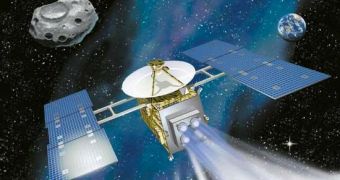Hayabusa, meaning peregrine falcon in Japanese, is an unmanned space mission carried out by the Japan Aerospace Exploration Agency, having the task of returning dust from the near-Earth asteroid known as 25143 Itokawa, measuring about 540 meters/ 270 meters/ 210 meters. Hayabusa was launched into space on 9 May 2003; however, during its trip to the Itokawa asteroid, it was hit by a large solar flare that destroyed most of its solar panel array, thus reducing the efficiency of most of its systems, including the ion engine used to power it through space.
By 12 September 2005, when it finally reached the Itokawa asteroid, Hayabusa was already crippled by numerous system failures. Nevertheless, on 19 November 2005, Hayabusa landed on the asteroid for the first time. By 8 December, JAXA lost all communication with the spacecraft and re-established it only by 7 March 2006.
This is only a summary of what happened to Hayabusa spacecraft, the list of problems experienced after it was hit by the solar flare is significantly longer. However, the probe is expected to return to Earth by 2010 and deliver its precious cargo. The problem is that the capsule containing the asteroid dust may never reach safely the surface of the planet. Hayabusa is now pointing into a direction that will either send the capsule back into deep space or into a trajectory that will destroy it during the re-entry into Earth atmosphere.
The fact is JAXA is not sure that the capsule even had a chance of collecting any asteroid dust. At its current status, the spacecraft would drop the capsule towards a region of the Australian continent on June 2010. "I get the sense from our Japanese colleagues that it's not a sure thing they'll get the capsule back to Australia," said Don Yeomans, from NASA's Jet Propulsion Laboratory. During 2005, it suffered a failure which resulted in the damage of two stabilizing gyroscopes and it has been losing fuel ever since.
JAXA engineers are now trying to stabilize the probe by using xenon gas jets from the ion propulsion unit, but the thrust is relatively weak, given the nature of the engine and the fact the it is deprived of electric energy. If the orientation of the probe is not modified by 2010, the capsule will probably bounce on the top of the Earth's atmosphere and will be lost forever, or the re-entry angle may be too steep, and it will burn due to high air friction. The best scenario would be for the capsule to simply miss the landing spot.
Nonetheless, its still worth a try to salvage what is left of the mission, according to Yeomans.
"Yeah, the spacecraft is hurting. It's a credit to the Japanese that they've had some work-arounds. It's the little spacecraft that could," said Yeomans. Amongst some of the other mission failures, it is worth to mention the Minerva miniature robot, which was supposed to hop across the surface of the asteroid, albeit it was accidentally released into deep space and never heard from it again.
However, the Hayabusa spacecraft was still able to send back to Earth some stunning images of the asteroid and to collect data regarding its surface. "It seems to be what we call a rubble pile, an object that was blasted apart and is held together by not much more than its own gravity. Most of the easy science has been done. Mostly we're just marking time until the sample capsule gets back - hopefully the sample gets back," said Yeomans.

 14 DAY TRIAL //
14 DAY TRIAL //